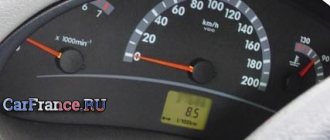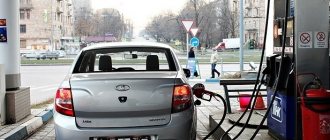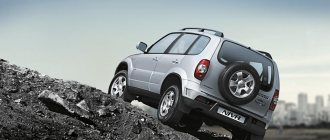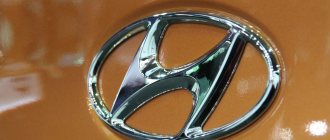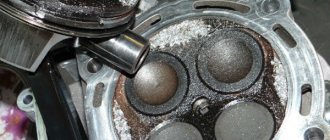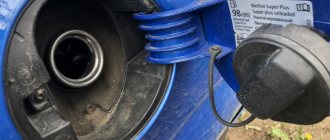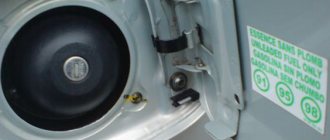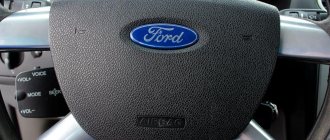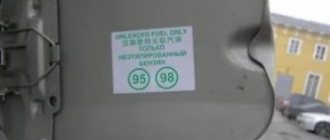Lada Largus what gasoline 92 or 95
The question that all car drivers ask themselves is: “Which gasoline should I choose, AI95 or AI92?”
Many people think that there is no need to save on fuel and fill in AI95, and sometimes AI98, AI98 G-drive or Euro. So which gasoline is better for Lada Largus? The manufacturer recommends that for Lada Largus engines (Renault K7M and K4M) use only unleaded gasoline with a research octane rating of at least 95 units “Premium-95” in accordance with GOST R 51105 or “Premium Euro-95” in accordance with GOST R 51866. For For the domestic VAZ 11189 engine, it is allowed to use gasoline of at least AI92.
The Autoreview website decided to check the efficiency and dynamics of AI92 and AI95 gasoline. Renault Sandero and Hyundai Solaris took part in the tests. According to the results of the study, it was found that when Renault Sandero was filled with AI95 gasoline, its maximum speed increased by 8 km/h, acceleration from 80 to 120 km/h became faster by as much as 7 seconds, and consumption decreased by 27%. Hyundai Solaris with AI95 also performed better than AI92, but not so pronounced. It turns out that the efficiency and dynamics of the car depend on gasoline, and all this is directly related to the type of engine.
The site for modifications and tuning of the VAZ 2110 decided to find the answer among the owners of the “ten”. According to the survey results, it turned out that the majority of drivers noticed a slight increase in dynamics on the AI95. In addition, AI95 fuel consumption is slightly less than AI92.
There are other tests on the Internet for gasoline with different octane numbers, some of them claim that the difference in engine power when using AI92 and AI95 gasoline does not change. But it is still not recommended to use gasoline with a low octane number, because... this will negatively affect the operation of the engine, which in the future may result in a major overhaul of the engine.
gasoline – AI92, AI95, AI98.
Once I filled it with AI95, the difference is not big. I can say I didn’t feel anything. 43 liters was enough for me for 377.4 km. There’s not even anything to say.
But then I filled it with AI92 and immediately felt the difference. Doesn't work. Acceleration is the same, but in the mountains it’s terrible. When starting off, I over-gassed it. 43 liters was enough for me for 372.6 km.
A modern engine has a “knock sensor” - it doesn’t care what kind of gasoline - the engine will adjust.
The detonation sensor is triggered after a detonation has occurred - several explosions have ALREADY occurred. According to the emergency program, the ignition timing shifts slightly - how much depends on the program. In the usual case, gasoline will burn out already in the exhaust manifold, even in the catalyst (he won’t thank you for this, don’t doubt it). If detonation still occurs, the emergency program “power reduced, move to the repair site” is activated. In simple words, the operation of the knock sensor turns on emergency mode. The engine doesn't "adjust" anywhere.
And the most important thing is the quality of gasoline. I have been convinced more than once that AI95 EKTO at LUKOIL is normal gasoline. So you decide for yourself what fuel to fill
it’s just a difference in gasoline AI92 - 29.05 rubles, AI95-32.20 rubles and AI98-34.30 rubles. If you live on a plain and don’t load a largush, then you can also refuel AI92. I advise you to drive AI95 gasoline, refuel at proven gas stations and the car will thank you.
Source
Highway consumption
In order to find out exactly how much fuel Largus consumes, it is necessary to separately evaluate consumption in urban conditions and on the highway. The second option will always have lower numbers, since driving outside the city does not require sudden acceleration and braking. Promotes reduction and movement at one, stable speed.
If we look at the reviews of car owners, the real consumption figures outside the city limits are 6.8-7.3 liters of AI-92 per 100 kilometers. If you remember the values indicated in the passport, then this parameter is indicated there as 6.3-6.7 liters. In principle, this is an insignificant difference.
The main enemy is detonation
The values “92” and “95” are called octane number and indicate the fuel’s ability to resist spontaneous combustion. It occurs due to high pressure in the cylinders and is called detonation.
Detonation is a process that destroys an internal combustion engine. Parts are subject to enormous wear and tear due to irregular operation. If the piston does not reach the end, a fuel explosion occurs, the forces of which direct it in the opposite direction. As a result, the engine is affected by opposing forces, which increase fuel consumption and reduce power.
The service life of an engine operating with detonation is 8 times lower than usual
Therefore, it is so important to avoid this phenomenon. You can “fight” detonation by refueling with high octane fuel
That is, the higher the octane number of the fuel, the less likely it is for detonation to occur.
It seems that the question has been answered. You need to fill in 95 gasoline and be sure that the engine is working properly, but not everything is so simple.
Just in case
Previously, at VAZ, for example, there was a certain unity of views; they believed that the 95 was better. And the arguments were simple: environmental friendliness, efficiency, acceleration, etc. Well, and a backup argument - a technological reserve that is laid down by the designer just in case. That is, if by pure “accident” you are flooded with something worse than 95, then nothing will happen to your engine.
Today there is no point in developing engines for the same 92nd. If only because in Europe there are no such figures anymore. The lower limit today is still 95.
What kind of gasoline to fill Kia Rio with?
We found out that it is recommended to fill this brand of car with 92 or 95 fuel. If you fill with low octane fuel, be prepared for the following:
- the machine will not operate at full capacity;
- the engine and fuel installations will become unusable faster than expected;
According to the owners of Kia Rio 3, it is best to fill with 95 gasoline, and the Kia Rio 1.6 model - with 92. But in reality, everything happens differently. As part of the task, an experiment was carried out where some users of the Kia Rio 3 brand filled the gas tank with AI-98, and the other part AI-92. In the first case, the owners noted an increase in acceleration and smoothness. The fuel with octane number 92 showed the opposite result, the car slowed down. Most often, such experiments on a car lead to accelerated wear of the engine and component systems. Therefore, we advise you to rely on the octane number specified in the operating instructions for your car brand.
However, if you decide to experiment and in the process realize that it is more comfortable to drive 95, then use this fuel. But do not forget about regular visits to service stations and engine checks. It’s worse if the owner fills it up after 95 with AI-92 gasoline, the octane number decreases and has a detrimental effect on the condition of the car’s engine. In this case, we recommend periodically refueling the 95 machine to clean it from soot and deposits. The difference between them is minimal; saving on consumption is pointless. Despite the presence of ether additives in 95, consumption during driving differs slightly from 92.
What determines actual gasoline consumption?
If the fuel consumption standards for a vehicle depend on the technical characteristics of the model (engine power, number of valves, cylinder volume), then the actual consumption is related to:
- Low quality fuel. Since at many gas stations special additives are added to gasoline to increase the octane number, traffic movement may become difficult, which causes an increase in consumption.
- A large number of electrical equipment in active mode. Since the operation of such elements requires energy, they actively take it away from the car, which also affects the increase in consumption. Moreover, this happens not only in Lada models, but also in any other brand.
- Engine heating. During the winter, a large share of gasoline is spent on these needs.
- Production of engine parts. The presence of problems in the fuel, exhaust, or cooling systems has a direct impact on fuel consumption, significantly increasing it. One of the signs of such a problem is the changed color of the exhaust gases.
- The terrain. While the driver may not visually notice a small hill, the car feels every bump. If the load increases with ascent, then the volume of fuel consumed changes accordingly, and vice versa, if the car is driving on a descent, then this indicator decreases.
- Weather conditions. With a strong tailwind, the car receives a small level of deceleration, so to eliminate it it is necessary to apply a greater load, as a result of which gas mileage changes. When driving in the rain, the car also spends more energy due to an increase in the rolling resistance of the tires, which also affects the amount of fuel consumed.
- Workload. Each passenger increases the weight of the vehicle, and therefore the gasoline consumption by several percent.
- The driver's driving style. With a sharp start and braking, the level of fuel consumed increases. On the contrary, during smooth movements with coasting, it decreases.
Does it make sense to change Lukoil to Rosneft and what domestic gasoline is better to fill in
The driving community never tires of being interested in the topic of priority gas stations. Of equal interest is the question of the preferred octane numbers of fuels. And this despite the fact that distributors of well-known oil concerns are located on busy highways, and the exact octane number is specified in the instructions for the car.
The question of choosing a fuel will dry up on its own when the picture with the gas station rating becomes clearer. So, in 2022, these two networks are actively competing with each other for an honorable third place. So it makes no sense to choose between them - both are held in high esteem, both have high-quality fuel of the 5th eco-category.
Environmental class
Standardizes the content of harmful substances. It is quite clear that the higher this parameter, the better the high-octane liquid. The nominal value is indicated in the PTS. It is recommended to cross it only in the direction of increase. It is possible to move less than the nominal value, but only for a short time - in extreme situations.
The difference between 5 and 4 categories is solely in the sulfur content: 10 ppm versus 50 ppm. The fifth class is aimed at extending the life of the neutralizer. You can find out the eco-discharge:
- On the column.
- In the documentation.
- On the check.
Eco-class should not be confused with the Euro designation. The latter is nothing more than a publicity stunt.
92nd or 95th
It would seem that the difference is small, but the topic is actively alive to this day. What is the reason for such popularity? There are two arguments:
- Fear of flooding the unimportant “fifth”.
- An undeniable desire to save money.
There are still drivers who claim that only the “second” one is done correctly and it is clean, that is, devoid of a large number of harmful additives. Thus, the question of what kind of gasoline to fill on a suburban highway is not relevant for them.
But not everything is clear here. Firstly, regarding the versatility of the 92nd, this has not been the case for a long time. Secondly, no one has canceled the instructions - everything is reflected there regarding the recommended octane number for a car. The engine is designed to work only with it, and therefore refueling with the required octane number will be the only right decision. At the same time, the factory dynamics will be maintained, and the consumption will be pleasantly surprising.
For those who like to save money, here are the numbers. The difference in price between 95 and 92 does not exceed 3-4 rubles. You get a savings of 100 rubles per tank. This is unjustified. It’s better to clean the engine from carbon deposits, don’t put too much pressure on the gas, brake with the engine, and drive in the “green lane.” When you change your driving style, the benefits become more noticeable. For example, Lada Vesta is capable of “eating” from 6 to 16 liters per hundred.
Owners of common small cars often ask the question: should they fill up with 92 or 95? We answer: officially the “second” is suitable for:
- Kia Rio.
- Renault Sandero/Logan.
- Hyundai Solaris.
- Renault Duster.
- Hyundai Creta.
- Lada Vesta/XRAY.
- Nissan Almera.
- Lada Largus.
“The fifth” is prescribed for Datsun and many Ladas: Kalina, Priora, Grant, the popular “top ten”. However, in emergency situations they are able to feed on AI-92.
Maybe 98th?
Quite recently there were marketing recommendations - everyone pour AI-98! Many have tried it and this is what they concluded:
- Expensive.
- There is no increase in power.
- Fuel consumption increases unjustifiably.
These are the conclusions that can be expected from owners of conventional naturally aspirated engines. The maximum prescribed detergent is 95, but not 98. The latter is the prerogative of highly forced supercharged engines that require power. For this they have:
- The optimal ignition timing angle has been selected.
- The valve timing is set accordingly.
- Provides a high compression ratio.
The last condition forces you to refuel with the “eighth”. After all, it has increased detonation resistance, which is necessary in a high-pressure combustion chamber.
Criteria for selecting Lada Largus oil
All oils are selected based on compliance with SAE, ACEA, API. In terms of composition, it is optimal to use semi-synthetics or synthetics for Lada Largus.
ASEA A1/ ASEA A2/ ASEA A3/ ASEA A5.
API SL, SM, SN.
Viscosity is suitable 0w30, 0w40, 5w30, 5w40, 10w30, 10w40,15w30, 15w40, but most often drivers fill in 5W-30.
Information on viscosity for a specific engine can be found in the motor oil interchangeability catalog: https://www.northsealubricants.com/en/oil-advisor
The catalog can be trusted, the data is taken from car manufacturers. In this case, you can choose not only oil for the engine, but also for the gearbox, power steering, brake system, and cooling system. That is, all liquids.
Original Lada oils
- LADA PROFESSIONAL 5W-40, semi-synthetic, Article number 1 l - 88888L15400100.
- LADA PROFESSIONAL 5W-40, semi-synthetic, Article number 4 l - 88888L15400400.
- Lada Ultra 5W-40 API SN/CF, synthetic, Article number 1 l - 88888L05400100.
- Lada Ultra 5W-40 API SN/CF, synthetic, Article number 4 l - 88888L05400400.
At the factory, the Lada Largus engine is filled with Elf Solaris Rnx 5w30 oil.
What factors influence the increase in gasoline costs?
The efficiency of cars of the Lada Largus family is influenced by:
- technical condition of the chassis and transmission;
- weight of cargo or number of passengers in the cabin;
- road profile and congestion;
- driving style;
- condition of gasoline injection nozzles and catalytic converter;
- average speed;
- air temperature and road surface condition;
- frequency of air conditioner use.
The efficiency of cars is influenced by the technical condition and driving style.
Efficiency is affected by the degree of grinding in of engine and transmission parts. The plant allows increased fuel consumption during the first 10-12 thousand km; after scheduled maintenance, consumption stabilizes.
Lada Largus which gasoline to fill 92 or 95, manufacturer's recommendations
Many Lada Largus owners wondered what kind of gasoline to pour into their favorite “iron horse”.
You can often come across this question on various automotive forums, but no one can give a clear answer. Let's try to consider and come to a conclusion, what kind of gasoline is needed for this car?
Recommendations from the AvtoVAZ plant
Standard gas pump at a gas station
Which of these will we choose for Largus?
According to the service book and manufacturer's recommendations, Largus must be filled with fuel with a medium or high octane number. So, the question arises, what kind of gasoline should be poured into the tank - AI-92, AI-95, AI-98, or the Premium and Euro varieties? In the same manual about the fuel system it is written that it is not lower than AI-95. This is due precisely to the effect on the fuel system, which better perceives this particular marking.
Renault engine manufacturer's recommendations
Lada Largus fuel filler flap indicating the type of gasoline
Since the Largus has a Renault engine, you should listen to this manufacturer when choosing gasoline.
An exact definition was found in the service book for the K4M and K7J engines. The fuel system must be filled with gasoline marked at least A-95E.
Gasoline consumption on the dashboard of Lada Largus
To reduce consumption, the manufacturer recommends using only 92 gasoline.
This fuel is designated AI-95 Euro on the domestic market.
Expert recommendations
In 2014, this car was tested on different types of fuel. Three cars with the same characteristics, into which AI-92, AI-95 and AI-98 were poured. Each of them was tested for different indicators.
When using AI-98, the engine overheated too much and the cooling fan could not cope. Therefore, experts noted that this brand of fuel is not very suitable for use in Lada cars.
When using AI-95, there was a noticeable increase in dynamics and a drop in consumption compared to AI-92. Thus, experts noted that the ideal option is to use this particular brand of fuel.
Motorists' experience
Based on the experience of motorists, we can say that AI-95 becomes the optimal option for use. After switching to this brand from AI-92, the dynamics noticeably increased, and the consumption decreased by almost 25%, which cannot but please the owners.
Also, auto mechanics note that when using AI-95, there is less deposits on the walls of the combustion chambers, and the fuel system becomes clogged and fails much less often. Therefore, it is recommended to fill Largus with this type of gasoline.
Economical driving
conclusions
An important point is the fact that the quality of gasoline leaves much to be desired, so the labeling is not important, but the quality is important. The French use the A-92E in their Renaults, and the effect is better than the domestic AI-95. The absence of impurities and third-party liquids makes gasoline higher quality
The absence of impurities and third-party liquids makes gasoline of higher quality.
Didn't find the information you are looking for? on our forum.
If you find an error, please select a piece of text and press Ctrl+Enter.
What cars was H4M installed on?
The H4M engine was harmoniously and rationally introduced into the creation of a large number of Nissan and Renault cars and was successfully adapted to each model.
Since 2012, it has been equipped with Renault cars, such as Arkana 1 (from 2022), Fluence 1 (from 2012 to 2022), Megane 3 (from 2013 to 2016), Sandero 2, Duster 1, Kaptur 1, Megane 4 , Logan 2 and Sandero 2 Stepway (since 2016), Logan 2 Stepway (since 2018).
The following Lada cars also received this engine: X-Ray hatchback (since 2016), Vesta sedan 2180, Vesta SW 2181, Vesta Cross 2180, Vesta SW Cross 2181 and X-Ray Cross (since 2019).
Real fuel consumption figures
Some cars are produced with 8 valves in engines. There are versions with 84 hp. and 87 hp The manufacturer promises that these cars will “eat” 10.5-10.6 liters on city streets and 6.5-6.9 liters on the highway. In reality, the values differ greatly.
For 84 hp engines. and 87 hp have approximately the same consumption in real conditions. The values are as follows:
- When driving in the city, in traffic jams and difficult traffic conditions - 12.4-13.8 l;
- If you often have to drive on the highway, between cities – 8.2-8.9 liters;
- When driving in the combined cycle - 10.1-10.9 liters.
Power plants 102 hp, 105 hp and 106 hp consume more gasoline than less powerful versions. However, the numbers are quite adequate, which contribute to fuel savings. In real conditions, the indicators are:
- Driving on city roads – 12.6-13.9 l;
- Driving on highways – 8.6-9.4 l;
- Driving both on the road and on the highway – 10.5-11.6 liters.
It must be borne in mind that consumption figures fluctuate greatly, depending on environmental conditions. In winter and at low temperatures, the specified gasoline consumption standards increase.
Those cars that are equipped with engines of 102 hp, 105 hp. and 106 hp have a basic design with 16 valves. This had a good effect on the power and dynamics of the car. Unfortunately, a negative trend towards increased gasoline consumption has emerged. For all these three engine variations, the numbers are approximately the same - we list them:
- Operating the car in the city, on a busy road – 12.5-13.6 l;
- Driving between populated areas on the highway – 8.9-9.7 l;
- Mixed operating cycle – 10.3-10.9 l.
Fuel consumption in urban conditions
If you mainly plan to drive along the streets of a large city, then you need to prepare for the fact that the “appetite” for gasoline will increase significantly. This will be affected by several factors:
- A driving style in which it is necessary to constantly brake sharply and pick up speed just as sharply;
- The need to stand in traffic jams;
- Parking with the engine running;
- Lower fuel quality.
If you look at the reviews of Largus owners on the Internet, they write that gasoline consumption values are 11.9-12.5 liters per 100 kilometers. Please note that if you measure this value in another vehicle, the values may differ. The reason for this is individual factors that make adjustments to the number of liters of gasoline spent per hundred. Experienced auto mechanics recommend measuring fuel readings only on an individual basis.
The secret of increased performance
Currently, manufacturers of Lada Largus cars indicate in the technical documentation attached to it the dimensions of their fuel tank, equal to approximately 50 liters. In fact, you can put a lot more gasoline into it. There are several reasons for this:
- relatively large fuel tank neck;
- deliberate application of a slightly smaller volume by manufacturers to comply with technical documentation;
- the presence of special voids in the tank that increase its level of wear resistance;
- errors in the operation of refueling equipment.
About the long neck
Naturally, the creators of the Lada Largus car, if possible, would indicate exactly 65 liters of fuel in the technical parameters, if they had such an opportunity. In fact, almost any car can be filled with slightly more gasoline than is indicated in the documentation. This is due to the fact that not the entire actual volume of the fuel tank is subject to accounting. The fact is that the neck is not an accounting space. At the same time, in the Lada Largus car it has increased dimensions in comparison with other models. As a result, several liters of fuel will easily fit there.
Fuel system Lada Largus
Better to play it safe
Another important point to understand is the fact that manufacturers indicate not the exact, but the approximate volume of the fuel tank. Moreover, in reality, in no case should it be smaller in size than what is written in the application from the manufacturer. It is for this reason that companies play it safe and indicate a slightly smaller fuel tank volume.
All gas stations lie
We should also not forget that unscrupulous gas stations can “increase” the amount of fuel they can hold without any problems. In fact, there are even officially indicated “miscalculations” of equipment during the process of pouring gasoline into a car. Most often we are talking about 50 ml per 10 liters. What can we say about unofficial “mistakes”.
Safety first
Another reason for such differences should be sought in the physical properties of gasoline itself. The fact is that during the heating process it expands quite strongly. So, if the fuel tank does not have additional volume, it can lead to failure. It is to avoid such excesses that any tank has special hollow protrusions. Under normal conditions, after firing the refueling nozzle, they are still empty. If you wait a little and try to continue refueling, these reserve spaces will also be filled.
Lada Largus 2012 – 2022
The front suspension is MacPherson strut with anti-roll bar, and the rear is an H-beam with trailing arms. High energy intensity and long wheel travel have long been the hallmark of cars built on the B0 platform; they don’t care about any potholes. In addition, roll and pitch are at an acceptable level. Largus has reinforced springs especially for high-load operation.
Of the entire suspension, ball joints have the shortest lifespan. When out of order, they give themselves away by constant tapping while moving. They wear out especially quickly in cars that often drive at or exceed the maximum permissible load. CV joint boots often break. If you do not notice this, you will soon hear a crunching sound when turning the steering wheel and you can prepare to replace the entire drive.
The front brakes are ventilated disc, rear drum. They have mediocre efficiency, but are quite predictable. Previously, ABS was an option, but now it is installed on all cars without exception. Due to their rigidity, original brake pads quickly render the discs unusable, and they are usually replaced together. High-quality analogues increase the life of brake discs by at least twice.
The steering is heavy but has good feedback. The car takes turns well, even at high speed. In addition, the steering rack rarely begins to knock or play to the point of extreme mileage. A regularly occurring problem is considered to be power steering leaks.
Real fuel consumption figures
Some cars are produced with 8 valves in engines. There are versions with 84 hp. and 87 hp The manufacturer promises that these cars will “eat” 10.5-10.6 liters on city streets and 6.5-6.9 liters on the highway. In reality, the values differ greatly.
For 84 hp engines. and 87 hp have approximately the same consumption in real conditions. The values are as follows:
- When driving in the city, in traffic jams and difficult traffic conditions - 12.4-13.8 l;
- If you often have to drive on the highway, between cities – 8.2-8.9 liters;
- When driving in the combined cycle - 10.1-10.9 liters.
Power plants 102 hp, 105 hp and 106 hp consume more gasoline than less powerful versions. However, the numbers are quite adequate, which contribute to fuel savings. In real conditions, the indicators are:
- Driving on city roads – 12.6-13.9 l;
- Driving on highways – 8.6-9.4 l;
- Driving both on the road and on the highway – 10.5-11.6 liters.
It must be borne in mind that consumption figures fluctuate greatly, depending on environmental conditions. In winter and at low temperatures, the specified gasoline consumption standards increase.
Those cars that are equipped with engines of 102 hp, 105 hp. and 106 hp have a basic design with 16 valves. This had a good effect on the power and dynamics of the car. Unfortunately, a negative trend towards increased gasoline consumption has emerged. For all these three engine variations, the numbers are approximately the same - we list them:
- Operating the car in the city, on a busy road – 12.5-13.6 l;
- Driving between populated areas on the highway – 8.9-9.7 l;
- Mixed operating cycle – 10.3-10.9 l.
Car owner experience
Skeptics cannot be convinced by any arguments until they check everything themselves. Driving experience shows that on the same route in the same operating mode, savings on high-octane petroleum products can amount to 0.5 liters per 100 km. At the same time, no changes are felt in the operation of the Rio engine: the same smooth running, dynamic acceleration, no detonation is heard.
But those who have driven 75 thousand km on a 92 alone talk about the complete destruction of the catalyst. If you do not keep track of the moment when ceramic particles fly into the combustion chambers, then major repairs cannot be avoided. Restoring the engine costs a lot of money, since the car is already out of warranty. Therefore, drivers with similar experience are encouraged to drive on high-octane gasoline.
An analysis of the fuel consumption of the Rio car showed:
- 2% of drivers drive an AI-98, which is not rational and dangerous for the engine due to overheating of the pistons and cylinders;
- 34% of motorists choose AI-95;
- 6% prefer 92nd.
Conclusion: follow the manufacturer’s recommendations, do not be afraid to use both types of fuel, but choose network gas stations with proven quality of petroleum products. According to statistics, most Kia Rio owners drive AI-92 gasoline.
What do car manufacturers recommend?
Many, and not without reason, believe that the manufacturers’ recommendations, which are reflected in the vehicle’s technical passport, should be strictly followed. Why is it not recommended to break them? Let's try to find out. If, according to the technical data sheet, the engine is intended for 95-grade gasoline, then some, trying to save money, fill it with 92-grade gasoline. Over time, this leads to a problem with the engine, and, naturally, through the fault of the car owner himself. According to the law of physics, the higher the octane, the lower the combustion temperature of the combustible mixture will be. But when using low-octane fuel, the opposite happens. This leads to burnout of some parts and to rapid unscheduled partial or overhaul of the engine. So, if a car must be refueled only with 95-grade gasoline, then you absolutely cannot “feed” it with 92-grade fuel, because this is fraught and you need to be extremely careful.
Source
Disputes about choosing the type of gasoline for a liftback
A similar question, about what kind of gasoline to fill Lada Granta cars with, is asked by car enthusiasts quite often. Sometimes they start thinking about it long before buying this car, and for good reason, because on the one hand, money savings depend on this, and on the other hand, the octane number of the fuel directly affects the driving dynamics of the car.
The following two tabs change content below.
I own a Renault Megane 2, before that there were Citroens and Peugeots. I work in the service area of a dealership, so I know the car inside and out. You can always contact me for advice.
What does the manual say?
If you open the Lada Granta manual, the text clearly states that the brand of recommended gasoline for this model is:
AI-95 "Premium"
or “Premium” EURO-5
, and GOST standards are indicated on them accordingly.
Why the manufacturer indicated such obligatory recommendations, we’ll try to figure it out below in our article!
- The first requirement that the manufacturer sets is the high requirements for ignition of a flammable liquid at subzero temperatures. Therefore, the higher the octane number of gasoline, the better.
- The second requirement is the presence of various additives in such gasoline, which are designed to protect against soot, destruction and corrosion. In addition, gasoline, which the plant does not recommend, in their opinion, contains organic and metal particles that negatively affect the performance of the engine as a whole.
Information from the official website
To summarize the above, we can say that the manufacturer’s requirements regarding the choice of fuel must be strictly followed in order not to experience problems with the engine and fuel system in the future.
What kind of gasoline do car enthusiasts choose?
- Based on the experience of Grantmakers from our portal, we came to the conclusion that there is complete chaos among owners when choosing the right type of fuel. One side directly says that it fills with AI-92 and the car drives without visible changes, but from time to time in the combustion chamber. At the same time, noting that there are no changes in the dynamics and smooth operation of the engine.
- The latter claim that they only fill AI-95
, while noting some fuel savings. And the third category claims that it fills both types of gasoline, thereby trying to achieve savings and reduce detonation. However, such an example does not have a very good effect on the behavior of the entire fuel system, and we do not recommend practicing this option for refueling your car.
How does the car manual answer this question?
So, to answer the question of whether it is possible to fill Granta with 92 gasoline, which worries many motorists, you should open the instructions on Appendix 1, which states that the recommended gasoline is “Premium 95” or “Premium Euro 5”. Why do the instructions contain such strict restrictions regarding gasoline?
Let's figure it out. The first note states that the required flammability at low temperatures must be ensured.
It follows from this that fuel must be selected of a certain volatility class. In different regions of the Russian Federation, this requirement is adhered to differently, and fuel volatility classes differ from each other based on location.
The second obstacle to the use of low-octane gasoline is various metal and organic particles, which are anti-knock agents and are contained in gasoline. The presence of lead, cadmium, manganese, iron and other metals can be observed in the particles.
Various additive materials are introduced into high-octane gasoline to prevent the formation of soot, various deposits and corrosion. But these substances can only be included in gasoline by its manufacturer. Every motorist can do this, but experts do not recommend doing this, since substances can be introduced in the wrong proportion.
What Gasoline to Pour into Kalina
So, for the entire time I owned my Kalina, which is already more than two years and the odometer mileage is over 40,000 km, I refueled with both the most expensive 95th and the cheapest 80th fuel (there were hopeless situations). And I would like to share my experience of refueling various types of fuel.
As the manufacturer recommends, even for 8-valve engines, it is necessary to fill in gasoline with the same octane number. At first, I listened to this advice, measured fuel consumption and for about 100 km at an average speed of 90 km/h the figure was no more than 5.5-5.8 liters.
I turned out the spark plugs and they were fine, there were no deposits or red deposits, the engine ran properly and smoothly. In short, everything suited me.
But after the car had traveled more than 10,000 km, and had also been run-in, I decided to try feeding it with cheaper gasoline, and below I’ll tell you about the shortcomings, if any!
92 Gasoline vs 98 / Test on Lada Kalina with power measurement
As you probably guessed, I didn’t notice any difference between the octane numbers at all. The same confident engine start, smooth operation at idle and at high speeds, no detonation and not even a hint that the car didn’t like anything.
After driving another 10,000 km only on 92nd fuel, I decided to unscrew the spark plugs again and assess their condition, and as it turned out, they were ideal, the same light gray color without the slightest deposits, which indicated a completely serviceable engine and power system .
As for consumption, this indicator has not changed at all throughout the entire time, the dynamics and traction remained the same. I concluded that the engine makes absolutely no difference to these changes of 3 units of octane number.
These, of course, were not experiments of their own free will, but my Kalina had to drive a couple of times even on the AI-80, which does not fit in with injection engines at all. There were cases when gas stations along the highway did not have other types of fuel, and therefore we had to get to the next station using what we had.
But, to be honest, when after filling five liters of this fuel into a completely dry tank, the car felt the same as on the 95th, I was simply shocked. Everything remained at the same level, consumption, acceleration and other characteristics.
Of course, I did not intend to carry out further such experiments, who knows what long-term operation would show, but the fact remains a fact.
My conclusion
Maybe for modern 16-valve engines the difference in octane numbers will be significant, and will somehow affect the parameters and characteristics of the engine, but on proven eight-valve 8-valve engines, I personally didn’t notice it at all. Yes, and by the way, regarding the 16th grade.
engines: a friend and I drove a ten and filled it with the cheapest eightieth gasoline several times, and everything worked like clockwork, so in this case there is something to think about.
Or maybe there is no difference at all between all these figures except for the price? After all, we must not forget what country we live in! And it has long been known that 95 in principle does not exist in Russia; it is made by adding all kinds of additives, which are unknown how they affect the engines of our cars, positively or negatively! I would like to hear from other car owners, what is your experience of refueling Kalina, and other cars, and do you notice a real difference (without any self-hypnosis) between one type of fuel or another?
see also
Comments 113
Good afternoon. Lew A95. Previously I tried A92, which is recommended by the manufacturer. Why did you switch to A95? 1. I don’t see any point in saving too much, since the difference in cost is small. In addition, in my opinion, the amount of 5,000 rubles. scattered over a year is absolutely miniscule. 2. I only pour gasoline at proven gas stations. It’s easier to waste money at poorly established gas stations and then argue about everything. The car drives in any case, but the driving mode on the A95 is quieter, calmer and feels more dynamic. 3. I did not specifically compare the costs of this or that gasoline. I wrote a review with personal observations about the car, including current fuel consumption after running-in. In general, I must note that my expenses, in my opinion, are quite good. I am satisfied with everything. 4. For some time now I have been keeping records of gas stations. I'll analyze the data someday. There is no time yet.
Increased consumption will definitely result. I compared it on 2112, on Largus the principle is the same. The engine will not be worse, but the fuel system will be 95 cleaner
Lew 92 if it's free. And so95. In terms of money it comes out the same, either 95 or 92 due to consumption
You need to choose not the OCH, but the gas station. On Lukoilovsky 92 it accelerates when cold without twitching, on Rosneft 92 there is twitching. In the heat it’s 95 on the highway, in the winter it’s a good 92 in the city.
I pour either 95 Lukoil. or free 92 bashneft
Buy a Chevrolet Tahoe. And don’t worry about gasoline.))) 92 is pouring.
